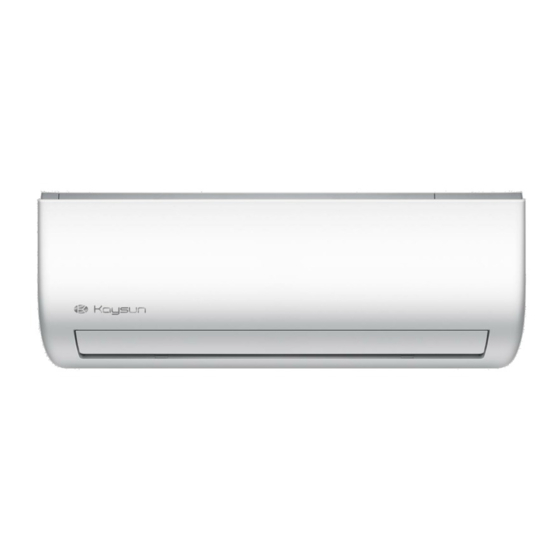
Table of Contents
Advertisement
Advertisement
Table of Contents
Troubleshooting

Summarization of Contents
Precaution
1.1 Safety Precaution
Instructions to prevent injury and property damage.
1.2 Warning
Warnings related to installation and general usage.
Function and Specifications
Model Names of Indoor/Outdoor Units
Lists model names for indoor and outdoor units.
Detailed Specifications
Comprehensive technical specifications for the unit.
Dimensions
3.1 Indoor Unit Dimensions
Detailed dimensions of the indoor unit.
3.2 Outdoor Unit Dimensions
Detailed dimensions of the outdoor unit.
Installation Details
5.1 Wrench Torque Sheet
Torque specifications for pipe connections during installation.
5.2 Connecting Cables
Guidelines for selecting power cord size based on appliance current.
5.3 Pipe Length and Elevation
Specifies pipe length and refrigerant amount based on model.
5.4 First-Time Installation
Procedures for initial installation, including leak testing and vacuuming.
5.5 Refrigerant Addition
Procedures for adding refrigerant for long pipes and after years of use.
Re-installation Procedures
5.6 Re-installation (Indoor Unit Repair)
Steps for re-installation after indoor unit repair.
5.7 Re-installation (Outdoor Unit Repair)
Steps for re-installation after outdoor unit repair.
Disassemble Guide
6.1 Filter Removal
Steps to remove the air filter from the indoor unit.
6.2 Horizontal Louver Removal
Steps to remove the horizontal louver from the indoor unit.
6.3 Indoor Unit Mounting for Piping
Method to secure the indoor unit for pipe connection.
6.4 Panel Assembly Removal
Steps to remove the front panel assembly of the indoor unit.
6.5 PCB and Electrical Box Removal
Procedure for removing the PCB and electrical control box.
6.7 Chassis Assembly Removal
Procedure for removing the chassis assembly of the indoor unit.
6.8 Evaporator Assembly Removal
Steps to remove the evaporator assembly from the indoor unit.
Operation Characteristics
Operating Temperature Ranges
Operating temperature ranges for cooling, heating, and drying modes.
Electronic Functions and Protections
8.1 Abbreviations
List of abbreviations used for sensors and parameters.
8.2 Display Functions
Explanation of display icons and digital readouts.
8.3 Main Protections
Details on various protection mechanisms for the unit.
Operation Modes and Functions
8.4.1 Fan Mode
Operation details for the fan-only mode.
8.4.2 Cooling Mode
Rules and protection mechanisms for cooling operation.
8.4.3 Heating Mode
Running rules and protection for heating operation.
8.4.3.4 Defrosting Mode
Operation during defrosting mode and conditions for termination.
8.4.4 Auto-Mode
How the unit selects cooling, heating, or fan-only modes automatically.
8.4.5 Drying Mode
Operation characteristics of the drying mode.
8.4.6 Forced Operation
How to operate the unit in forced cooling or auto mode.
8.4.7 Economy and Sleep Functions
Details of the economy and sleep functions.
8.4.8 Auto-Restart Function
Functionality for resuming operation after power failure.
8.4.11 Self Clean (Optional)
Functionality for self-cleaning the indoor unit.
8.4.12 Follow Me (Optional)
How the remote sensor affects unit operation.
8.4.13 Silence Operation (Optional)
Operation to reduce noise level.
8.4.15 Point Check Function
Function to access information enquiry status.
Information Enquiry and Control Options
Information Enquiry Codes
Table of enquiry information codes and their meanings.
8.5 Multi-function Board Instructions
Instructions for the optional multi-function control board.
8.5.2 CP Remote On-Off & 8.5.3 ON-OFF Control
Settings for remote and general ON-OFF control.
8.5.4 Controller Types & 8.5.7 Wiring Diagrams
Information on controller types and their wiring diagrams.
Troubleshooting
Safety Precautions for Troubleshooting
Safety precautions related to electrical discharge during troubleshooting.
9.1 Indoor Unit Error Display
Table of error codes and their corresponding LED status.
9.2 Troubleshooting Guide
Diagnostic steps for specific error codes and their solutions.
9.2.1 EEPROM Parameter Error (E0/F4)
Diagnosis and solution for EEPROM parameter errors.
9.2.2 Communication Error (E1)
Diagnosis and solution for communication errors between units.
9.2.3 Fan Speed Control Error (E3/F5)
Diagnosis and solution for fan speed control issues.
9.2.4 Refrigerant Leakage Detection (EC)
Diagnosis and solution for refrigerant leakage detection.
9.2.5 Temperature Sensor Errors (E4/E5/F1/F2/F3)
Troubleshooting for temperature sensor related errors.
9.2.6 Overload Current Protection (F0)
Diagnosis and solution for overload current protection.
9.2.7 IPM Malfunction / Over-current Protection (P0)
Diagnosis for IPM/IGBT malfunction and over-current protection.
9.2.8 Voltage Protection (P1)
Diagnosis for over/under voltage protection.
9.2.9 Compressor Top Temperature Protection (P2)
Diagnosis for compressor top high temperature protection.
9.2.10 Inverter Compressor Drive Error (P4)
Diagnosis for inverter compressor drive errors.
Main Parts Check
1. Temperature Sensor Checking
Procedure to check temperature sensors using a tester.
2. Compressor Checking
Procedure to check compressor winding resistance.













Need help?
Do you have a question about the KAE-52 DN7 and is the answer not in the manual?
Questions and answers